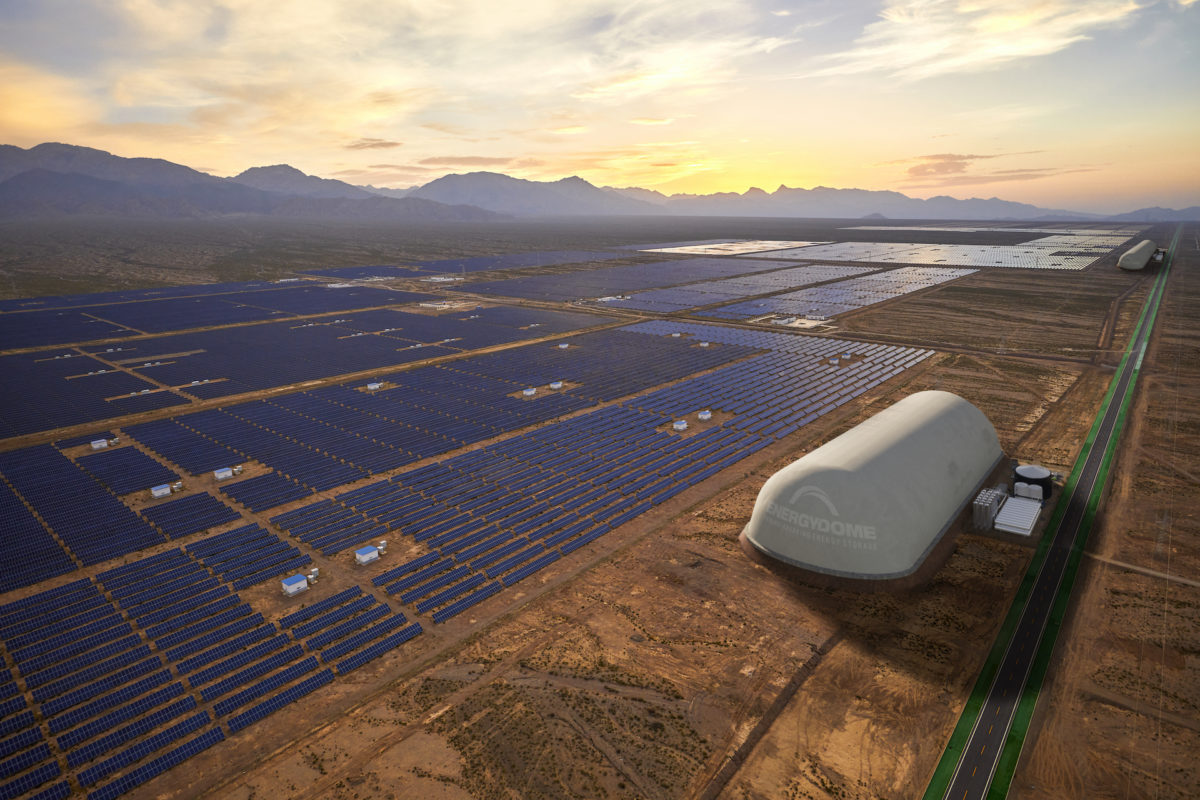Italy-based Energy Dome has developed a modular, scalable system for utility-scale, long-term electricity storage based on compressed CO2. It claims that the system is a non-site-dependent solution for storing wind and solar power, as well as grid electricity.
“The concept is the same as compressed air energy storage (CAES) and liquid air technologies” Energy Dome CEO Claudio Spadacini told pv magazine. “With the difference, however, that storing CO2 can be done by occupying less space than with compressed air and without the need for finding a cavern or implementing underground works.”
The reduced volume at ambient temperature, which is required by the technology on the high-pressure side of the system, is the “secret sauce” for the CO2 battery’s competitive costs and high performance, according to its creators. These main features depend on the fact that CO2 becomes liquid with ambient temperature and pressure of only 70 bars.
“Unlike CAES and liquid air technologies, our storage concept is non-site dependent and can be applied almost anywhere without having to deal with extreme cryogenic temperatures,” said Spadacini.
The system draws CO2 from an inflatable atmospheric gas holder, which the company named Dome, and stores it under a 70 bar pressure at ambient temperature in a high-density liquid state. When the stored energy is needed, the CO2 is evaporated and conveyed through a turbine that produces power. After this process is implemented, the CO2 goes back to the atmospheric gas holder to be used again for another storage cycle, without any emissions to the atmosphere.
“It is a closed-loop cycle and no CO2 is released in the atmosphere,” Spadacini said. “The system, on the other hand, doesn't need too much CO2 to work, I would say a few hundred tons would be enough for about 100 MWh of electricity.”
One of the Energy Dome’s main advantages, he said, is that this technology uses off-the-shelf components. There is no need for a new factory to be put up and running in order to have a plant built, nor extensive testing time of new turbomachinery or new chemical reactions.
Popular content
The system's optimal charge/discharge cycle should range from four to 24 hours which, according to the company, makes it perfectly suitable for daily and intra-day cycling when used for energy storage by grid operators and utilities. Its round-trip efficiency can reach up to 80%. The system modular design enables the construction of facilities with a storage capacity of up to 200 MWh.
“We expect a levelized cost of storage (LCOS) of our technology already below $100/MWh with the first commercial plant we are going to build. With wider deployment of our technology, we are aiming to drop the LCOS below $60/MWh in a few years’ time,” Spadacini said.
Energy Dome has recently raised $11 million through a Series A funding round and intends to use the proceeds for its first 2 MW/4 MWh pilot project in Sardinia, which it is developing in partnership with Italian utility A2A.
“This project will be tested for grid electricity storage in the first quarter of next year,” Spadacini explained. “But our technology is also intended for the storage of power generated by large-scale wind and solar plants.”
The company is targeting markets such as North America, South America, Europe, the Middle East, India and Australia.
“Our technology allows for worldwide deployment of competitive energy storage plants without any geographical limitations,” concluded Spadacini.
This content is protected by copyright and may not be reused. If you want to cooperate with us and would like to reuse some of our content, please contact: editors@pv-magazine.com.



Any idea how many tons of CO2 they use? Is this a possible use for some of the captured CO2 from power plants, etc?
It’ll be nice to explore the application to Electri Vehicles
Interessant, besonders der versprochene Wirkungsgrad von bis zu 80%.
Ein paar hundert t CO2 benötigen gasförmig allerdings ein kaum realisierbares Volumen.
z.B. benötigen 200 t CO2 bei atmosphärischem Druck ein “Dome” mit ca. 100.000 qm Inhalt, das wäre z.B. ein Würfel mit 46 m Seitenlänge.
Geht es hier nur um die Tatsache, dass viele technische Berichte mit Zahlen und Dimensionen auf Kriegsfuß stehen?